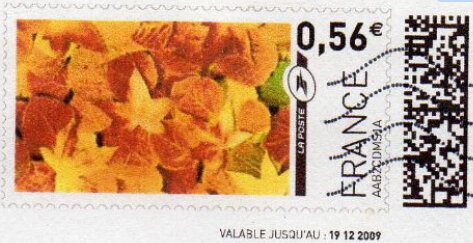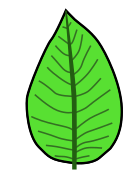Stamp: More Autumn Leaves (France 2009)
More Autumn Leaves (France 2009)
01 January (France ) within release MonTimbrEnLigne. Nature and Landscapes goes into circulation Stamp More Autumn Leaves face value 0.56 Euro
| Stamp More Autumn Leaves in catalogues | |
|---|---|
| Colnect codes: | Col: FR-TIM 2009-134 |
Stamp is square format.
Also in the issue MonTimbrEnLigne. Nature and Landscapes:
- Stamp - Crocuses face value 1.65;
- Stamp - More Autumn Leaves face value 0.56;
- Stamp - River Torrent face value 0.56;
- Stamp - Cherry Tree face value 0.56;
- Stamp - Forest. looking up into the canopy face value 0.56;
- Stamp - Trees in the autumn by a lake face value 0.56;
- Stamp - Horse chestnut leaves face value 0.56;
- Stamp - Pink Flowers maybe cherry blossom face value 0.56;
- Stamp - Tropical Beach 3 face value 0.56;
- Stamp - Orange and yellow flowers face value 0.58;
- Stamp - Frangipani (Plumeria) face value 0.55;
- Stamp - Snow Topped Mountains in black face value 2.30;
- Stamp - Women holding a sort of sunflower on a stick face value 0.56;
|
Data entry completed
46%
|
|
|---|---|
| Stamp More Autumn Leaves in digits | |
| Country: | France |
| Date: | 2009-01-01 |
| Emission: | Cinderella |
| Format: | Stamp |
| Face Value: | 0.56 Euro |
Stamp More Autumn Leaves it reflects the thematic directions:
utumn, also known as fall in North American English,is one of the four temperate seasons on Earth. Outside the tropics, autumn marks the transition from summer to winter, in September (Northern Hemisphere) or March (Southern Hemisphere). Autumn is the season when the duration of daylight becomes noticeably shorter and the temperature cools considerably. Day length decreases and night length increases as the season progresses until the winter solstice in December (Northern Hemisphere) and June (Southern Hemisphere). One of its main features in temperate climates is the striking change in colour for the leaves of deciduous trees as they prepare to shed.
A leaf (pl.: leaves) is a principal appendage of the stem of a vascular plant usually borne laterally aboveground and specialized for photosynthesis. Leaves are collectively called foliage, as in "autumn foliage", while the leaves, stem, flower, and fruit collectively form the shoot system. In most leaves, the primary photosynthetic tissue is the palisade mesophyll and is located on the upper side of the blade or lamina of the leaf but in some species, including the mature foliage of Eucalyptus,palisade mesophyll is present on both sides and the leaves are said to be isobilateral. Most leaves are flattened and have distinct upper (adaxial) and lower (abaxial) surfaces that differ in color, hairiness, the number of stomata (pores that intake and output gases), the amount and structure of epicuticular wax and other features. Leaves are mostly green in color due to the presence of a compound called chlorophyll which is essential for photosynthesis as it absorbs light energy from the sun. A leaf with lighter-colored or white patches or edges is called a variegated leaf.


